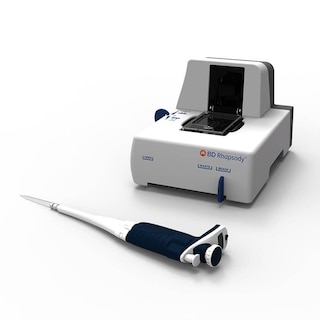-
Reagents
- Flow Cytometry Reagents
-
Western Blotting and Molecular Reagents
- Immunoassay Reagents
-
Single-Cell Multiomics Reagents
- BD® OMICS-Guard Sample Preservation Buffer
- BD® AbSeq Assay
- BD® Single-Cell Multiplexing Kit
- BD Rhapsody™ ATAC-Seq Assays
- BD Rhapsody™ Whole Transcriptome Analysis (WTA) Amplification Kit
- BD Rhapsody™ TCR/BCR Next Multiomic Assays
- BD Rhapsody™ Targeted mRNA Kits
- BD Rhapsody™ Accessory Kits
- BD® OMICS-One Protein Panels
-
Functional Assays
-
Microscopy and Imaging Reagents
-
Cell Preparation and Separation Reagents
-
- BD® OMICS-Guard Sample Preservation Buffer
- BD® AbSeq Assay
- BD® Single-Cell Multiplexing Kit
- BD Rhapsody™ ATAC-Seq Assays
- BD Rhapsody™ Whole Transcriptome Analysis (WTA) Amplification Kit
- BD Rhapsody™ TCR/BCR Next Multiomic Assays
- BD Rhapsody™ Targeted mRNA Kits
- BD Rhapsody™ Accessory Kits
- BD® OMICS-One Protein Panels
- Belgium (English)
-
Change country/language
Old Browser
This page has been recently translated and is available in French now.
Looks like you're visiting us from United States.
Would you like to stay on the current country site or be switched to your country?
BD™ AbSeq Oligo Hamster Anti-Mouse CD95 (Fas)
Clone Jo2 (RUO)


Regulatory Status Legend
Any use of products other than the permitted use without the express written authorization of Becton, Dickinson and Company is strictly prohibited.
Preparation And Storage
Recommended Assay Procedures
Put all BD® AbSeq Reagents to be pooled into a Latch Rack for 500 µL Tubes (Thermo Fisher Scientific Cat. No. 4900). Arrange the tubes so that they can be easily uncapped and re-capped with an 8-Channel Screw Cap Tube Capper (Thermo Fisher Scientific Cat. No. 4105MAT) and the reagents aliquoted with a multi-channel pipette.
BD® AbSeq tubes should be centrifuged for ≥ 30 seconds at 400 × g to ensure removal of any content in the cap/tube threads prior to the first opening.
Product Notices
- This reagent has been pre-diluted for use at the recommended volume per test. Typical use is 2 µl for 1 × 10^6 cells in a 200-µl staining reaction.
- The production process underwent stringent testing and validation to assure that it generates a high-quality conjugate with consistent performance and specific binding activity. However, verification testing has not been performed on all conjugate lots.
- Please refer to bd.com/genomics-resources for technical protocols.
- Caution: Sodium azide yields highly toxic hydrazoic acid under acidic conditions. Dilute azide compounds in running water before discarding to avoid accumulation of potentially explosive deposits in plumbing.
- Source of all serum proteins is from USDA inspected abattoirs located in the United States.
- Illumina is a trademark of Illumina, Inc.
- Please refer to http://regdocs.bd.com to access safety data sheets (SDS).
- For U.S. patents that may apply, see bd.com/patents.
Data Sheets
Companion Products






Fas antigen, CD95, is a 45 kDa cell-surface protein which can mediate apoptosis. It belongs to the TNF (tumor necrosis factor)/NGF receptor family. Expression of Fas has been described in the thymus, liver, heart, lung and ovary. Fas plays an important role in the apoptotic process that takes place during development. Monoclonal antibodies recognizing Fas such as Jo2 have cytolytic activity on cells expressing Fas. The cell death stimulated by Fas antibodies is characteristic of apoptosis and suggests that the lethal effects are a result of interaction of antibody with a functional Fas antigen as opposed to complement-mediated lysis.
The Jo2 antibody recognizes mouse Fas. The Jo2 antibody shows cytolytic activity against cell lines expressing mouse Fas by inducing apoptosis. Intraperitoneal injections of Jo2 mAb have been shown to kill mice and induce apoptotic hepatocyte death. Jo2 mAb has been reported to immunoprecipitate mouse Fas as a 45 kDa band from W4 cells. W4 cells are WR19L mouse lymphoma cells transformed with mouse Fas. The difference between the observed MW of Fas and that deduced from its amino acid sequence (Mr 34,971) may be due to glycosylation.
Development References (9)
-
Enari M, Hug H, Nagata S. Involvement of an ICE-like protease in Fas-mediated apoptosis. Nature. 1995; 375(6526):78-81. (Clone-specific: Functional assay). View Reference
-
Hiromatsu K, Aoki Y, Makino M, et al. Increased Fas antigen expression in murine retrovirus-induced immunodeficiency syndrome, MAIDS. Eur J Immunol. 1994; 24(10):2446-2451. (Clone-specific: Cytotoxicity, Flow cytometry, Immunoprecipitation). View Reference
-
Kagi D, Vignaux F, Ledermann B, et al. Fas and perforin pathways as major mechanisms of T cell-mediated cytotoxicity. Science. 1994; 265(5171):528-530. (Clone-specific: Flow cytometry, Functional assay). View Reference
-
Nagata S. Apoptosis regulated by a death factor and its receptor: Fas ligand and Fas. Philos Trans R Soc Lond B Biol Sci. 1994; 345(1313):281-287. (Clone-specific: Functional assay). View Reference
-
Nagata S. Fas and Fas ligand: a death factor and its receptor. Adv Immunol. 1994; 57:129-144. (Clone-specific: Functional assay). View Reference
-
Ni R, Tomita Y, Matsuda K, et al. Fas-mediated apoptosis in primary cultured mouse hepatocytes. Exp Cell Res. 1994; 215(2):332-337. (Clone-specific). View Reference
-
Ogasawara J, Suda T, Nagata S. Selective apoptosis of CD4+CD8+ thymocytes by the anti-Fas antibody. J Exp Med. 1995; 181(2):485-491. (Clone-specific: Flow cytometry, Immunoprecipitation). View Reference
-
Ogasawara J, Watanabe-Fukunaga R, Adachi M, et al. Lethal effect of the anti-Fas antibody in mice. Nature. 1993; 364(6440):806-809. (Immunogen: Functional assay, Immunoprecipitation). View Reference
-
Yang Y, Mercep M, Ware CF, Ashwell JD. Fas and activation-induced Fas ligand mediate apoptosis of T cell hybridomas: inhibition of Fas ligand expression by retinoic acid and glucocorticoids. J Exp Med. 1995; 181(5):1673-1682. (Clone-specific: Flow cytometry). View Reference
Please refer to Support Documents for Quality Certificates
Global - Refer to manufacturer's instructions for use and related User Manuals and Technical data sheets before using this products as described
Comparisons, where applicable, are made against older BD Technology, manual methods or are general performance claims. Comparisons are not made against non-BD technologies, unless otherwise noted.
For Research Use Only. Not for use in diagnostic or therapeutic procedures.